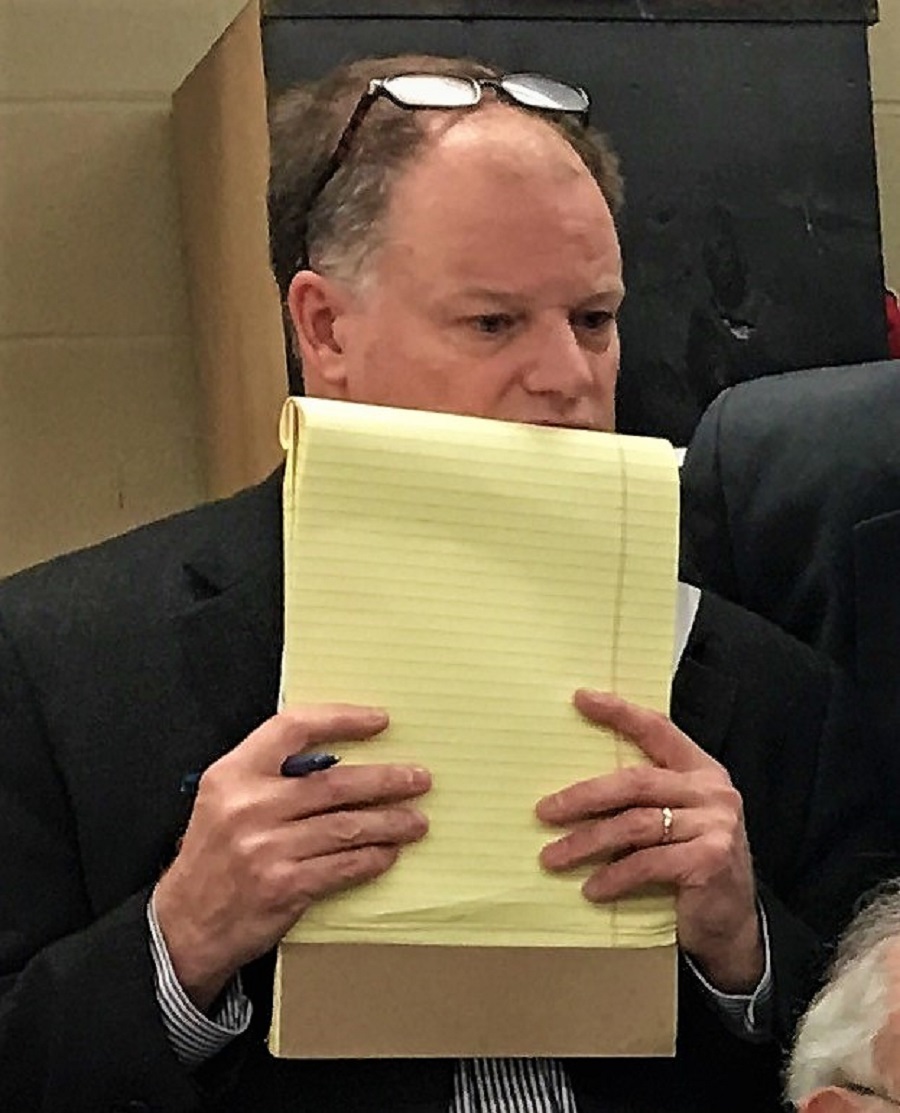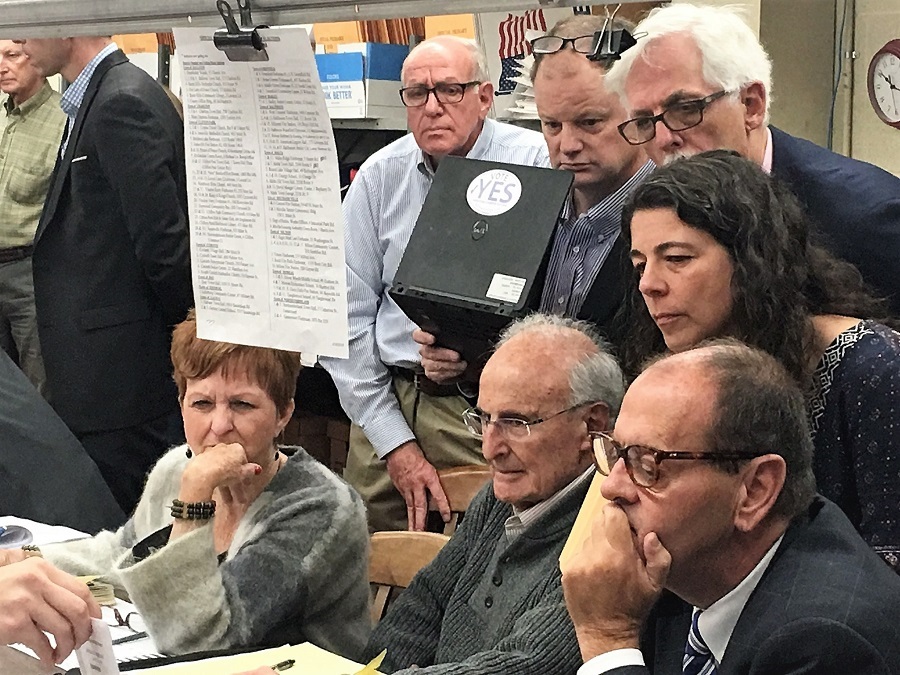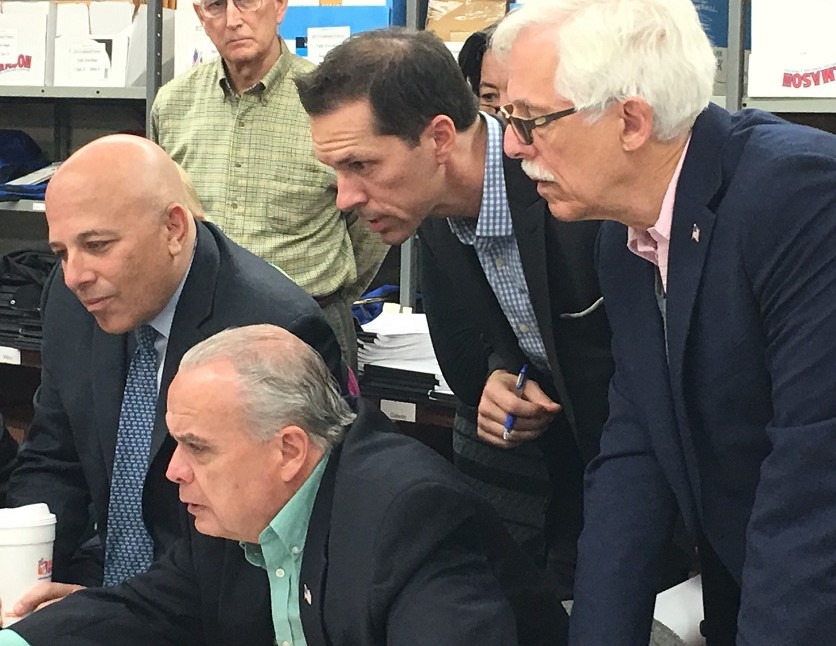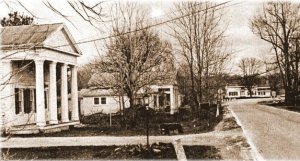Displaying items by tag: saratoga charter
New City Charter Heads to Public Referendum in November
SARATOGA SPRINGS – The mayor-appointed City Charter Commission has completed their work on a 38-page document which proposes a new City Charter. The proposition goes to public referendum on Nov. 6. If approved, the new Charter becomes effective on Jan. 1, 2019 – effectively repealing the city’s existing 2001 Charter.
A second part of the referendum seeks to increase the voting members of the City Council from five to seven. If that second proposal is approved by voters – that referendum also takes place Nov. 6 – the addition of the two council-members-at-large will become effective Jan. 1, 2020. As such, city voters in November 2019 – the next scheduled vote to elect the council – could be headed to the polls to vote for seven council members, instead of the traditional five. It is anticipated there would be a list of candidates for council members-at-large on the ballot, and the two candidates receiving the highest number of votes would then serve as council members-at-large.
Specifically, the Nov. 6 ballot will contain two separate questions about the Saratoga Springs City Charter.
1. Shall the Saratoga Springs City Charter be amended as proposed by the 2018 Charter Review Commission?
2. Shall the Saratoga Springs City Charter be further amended to provide for two (2) additional City Council members whose authority shall be legislative only?
Voters who choose to approve the first question – changing the City Charter – may also vote on whether to approve the second question. The initiative – adding two council members-at-large, cannot be enacted without a “yes” vote on both questions.
The 2018 Charter Review Commission was formed on March 6, 2018 by Mayor Meg Kelly with the goal of finding efficiencies and organizational improvements to better serve the people who live and work in the City of Saratoga Springs. The ten-member City Charter commission is comprised of the following members: City Attorney Vincent J. DeLeonardis, Chairman; Deputy Commissioner of Finance Mike Sharp, Vice Chairman; Deputy Commissioner of Public Safety John Daley, Secretary; Commissioner of Finance Michele Madigan; Commissioner of Public Works Anthony “Skip” Scirocco; Commissioner of Public Safety Peter Martin; Commissioner of Accounts John Franck; Deputy Mayor Lisa Shields; Deputy Commissioner of Public Works Joe O'Neill; Deputy Commissioner of Accounts Maire Masterson.
City Attorney Vincent DeLeonardis served as chairman of the Commission. This week, he sat down with Saratoga TODAY and discussed some of the proposed changes.
- What is the status of the proposal?
- We have completed our review, drafted our proposed recommendations and filed that (on Sept. 6) with the city clerk. The document will now be forwarded to the county Board of Elections and it will be on the ballot on Nov. 6. It will be on the ballot, by the way, as two separate questions.
Through our process of drafting proposed amendments, we have all of those incorporated into a draft charter relating to the first question that the voters will have: whether they will approve the Charter as amended by the Charter Review Commission.
A separate question is whether they will further amend the Charter to incorporate the two additional at-large council members.
If they vote yes for question 1 to amend the charter, they will then vote on whether it will be further amended to address the two at-large council members, but if question 1 does not get approval, then question two does not go into effect.
How would the two at-large council members work?
- If approved by the voters, the two at-large council members will have legislative responsibility only and would not have any administrative or departmental responsibilities at City Hall.
Will they be paid positions?
- They would be, but salaries are to be determined by council. The amount of the salary is not contained in the Charter itself. The amount of any salary to be provided to the council members at-large would be established by the City Council in accordance with Local Law. That would be decided after the vote passes. (Note: at-large members would not have deputies).
Would the council members at-large attend every council meeting?
- They would be expected to. They will be full members of City Council.
What influenced the idea to consider expanding the voting council from five to seven members?
- I think as a commission we were aware of certain public concerns that the responsibilities of the five council members may prevent qualified citizens from seeking public office. So, there is an opportunity to serve in city government as a member-at-large, and not be responsible for running a city department. It would enlarge the opportunity for individuals to participate in city government. They are charged with being fully involved in all voting procedures. They will be full members of the City Council, they just will not run a department.
Would there be a specific criteria or requirement for members at-large?
- No, it’s an elected position and it’s up to the people to decide who they put as members of the City Council.
What are your thoughts about the overall review process with the commission?
- I thought the process was positive. The commission worked well together, and we had a level of respect and professionalism that assisted in the process of getting things done.
What are some of the proposed changes to the Charter?
- Generally we’ve re-numbered and re-organized certain sections, provided amendments to the existing Charter - including new sections. and of course, there’s the separate and distinct question submitted in respect to council members at-large. More specifically, there are a number of things we did not change (such as) term limits. That was one thing that had been raised, but we did not make changes to it. In a number of areas we eliminated things like specific job titles and outlined department functions. We’ve incorporated requirements related to the State of the City (Address) – that it be presented by the entire City Council, rather than just the mayor. We have also required that appointments to the Land Use Boards – including the Planning Board, the Zoning Board of Appeals, and the DRC – which are still to be made by the mayor, will now be made with the advice and consent of counsel and will require a vote. And, the Rec Commission and the Recreation Department was moved from the Mayor’s Department to the DPW.
Will there be Public Hearings?
- We did receive an invitation from SUCCESS – who is hosting an event at the Library on Oct. 3 – and so we accepted that invitation and we’re looking forward to presenting at the library on that date. We’re also reaching out to other organizations and entities for meetings.
Note: The Saratoga Springs Charter Review Commission will give a presentation on the proposed charter changes at 6:30 p.m. on Wednesday, Oct. 3 in the H. Dutcher Community Room of the Saratoga Springs Public Library. A Q&A session will follow. This meeting is being sponsored by SUCCESS and is open to the public.
Split City: Charter Challenge Underway
SARATOGA SPRINGS – An Election Day vote that split city voters nearly down the middle may be revisited in the next few weeks, following the filing of a petition seeking a recanvas in the referendum on charter reform.
On Nov. 24, an action was commenced in New York State Supreme Court in the hope of seeking a full review and recount – called a recanvass - of all ballots cast in the Election Day referendum for a new city charter. The action was initiated by Gordon Boyd - who filed the request as an independent voter, and on behalf of “other private individuals” who supported the campaign for charter change.
The Election Night tally depicted a 48-vote lead in favor of charter change of the nearly 8,500 ballots cast; Following the opening of absentee ballots a week later the lead shifted, with votes in favor of maintaining the status quo ahead by a 10-vote difference: 4,458 to 4,448. Approximately half the city’s eligible 18,000 voters took part in the vote.
“The current margin of 10 votes out of nearly 9,000 cast means that a review of all ballots and scanner machine records is imperative to assure that the voters can have confidence in the final count,” said Boyd. Boyd is a former member of the Saratoga Springs Charter Review Commission, which disbanded on Election Day, as well as a contributor It's Time Saratoga! – a group that advocated for charter change.
“A complete hand recount would take only a few days, would eliminate any doubt that the machines may have miscounted, and would serve the voters above all else,” said Bob Turner, former chairman of the commission.
According to Turner, an assistant professor of Skidmore College’s Environmental Studies and Sciences Program, 20 states and the District of Columbia provide for automatic recounts if the margin between the top two candidates is within certain parameters - typically 0.5 percent or less of votes cast for office or issue. The margin in the charter referendum is 10 votes or one-tenth of 1 percent of the near-9,000 votes cast.
“Our goal is to determine with utmost certainty that the final vote tally is valid. Voting machines are not 100 percent accurate, which is why we are asking for a full recount of all ballots. It was so close that machine errors, if any, could have affected the vote,” Boyd said.
Election law attorney Joshua Ehrlich has been hired by Boyd and it is expected a hearing could potentially be held on or around Dec. 20 in front of a judge who will subsequently decide whether an election recount will be conducted. Boyd would not comment about how much money was raised to hire the attorney, and a phone message to Ehrlich seeking comment for this story was not returned.
Electronic data used during the election – paper ballots and flash memory cards – have been secured by the Board of Elections in a vault, as is common practice.
At issue is the current Commission form of governing in Saratoga Springs, which relies on five elected part-time council members, each of whom are responsible for administering their own department, as well as serving as legislators. The proposed charter change to a Council-Manager form of governing would take effect in 2020 and would see that the council hires a non-partisan, professional city manager to carry out city policies.

Memo from Turner
Heading into the final 11 days prior to the Nov. 7 referendum, It's Time Saratoga! had nearly $19,500 in its campaign spending balance. SUCCESS – a group in favor of maintaining the current charter - had just over $25,000 on hand. The total funds raised and spent by both camps won’t be known until Dec. 4, when 27-day post-election filings are due at the state Board of Elections. The official certification of the election by the board is anticipated to occur at about the same time.
“We trust the Board of Elections as being extremely professional and competent and see no reason for the recount,” said SUCCESS group member Richard Sellers.
Every Vote Counts: 10 Ballots Split the Difference Between Yes and No in City Charter Referendum
BALLSTON SPA – They descended on the village of Ballston Spa Tuesday – politicians and lawyers and election officials, members of the media and curious onlookers – on an unpredictable morning which gave no hint of the cold winter that will surely come, and no clue about how the prized chips of the day might fall.
All present crowded into a sub-level room at the county complex, Building Number Five. The “solar building,” as employees call it, was constructed atop land deeded to Saratoga County nearly 200 years ago by a New York City merchant named Nicholas Low for the development of a County Clerk’s office, assuring Ballston Spa would stand at the center of county government.
On this day, the 30-or-so people inside the building’s sub-level basement came to witness the opening and counting of approximately 550 absentee ballots. Some carried with them a cautious optimism to re-affirm the seat they’d won on Election Night remained secure, others with an angst-riddled hope that what they had lost might be regained. Most came to witness the counting of votes of the public referendum that could change the only form of governing the city of Saratoga Springs has known in its 102-year history.
The Election Night tally depicted a city divided and a race too close to call. Of the nearly 8,500 ballots cast, the difference was a measly 48 votes. There were 4,202 YES votes cast that urged Charter Change. There were 4,154 NO votes registered in favor of maintaining the status quo. The counting of the absentee ballots, most assumed, would settle the final score.
The current Commission form of governing relies on five elected part-time council members, each of whom are responsible for administering their own department, as well as serving as legislators. The proposed Council-Manager form of governing would see that the council hires a non-partisan, professional city manager to carry out city policies.

10:16 a.m.: The first handful of ballots are taken from their envelopes and displayed to watchers. Saratoga Springs District Two, Embury Apartments: Yes. No. Yes. No. No. Yes. No. No. Attorneys scrawl stick figures atop their legal pads. The No’s have gained two votes. The overall Yes lead of 48 drops to 46.
11 a.m.: More districts come in. The count: 18 Yes, 32 No. Overall Yes lead drops to 34.
12:30 a.m.: Break for lunch. The count on the day: Yes 128, No 161. Yes lead drops another 19 votes. Math update, overall: Yes 4,330, No 4,315. Overall Yes lead drops to 15. Fortified by sandwiches and fueled by caffeine, everyone returns from lunch and is moved upstairs to a bigger room. First up, one of the Senior Citizens Center’s voting districts. Result: 7 Yes, 14 No. Overall: 4,337 to 4,329. Yes lead up by eight.
2:02 p.m.: Saratoga Springs High School Gym voting district - 10 Yes, 17 No. Overall: 4,347 to 4,346. Yes clings to the lead by one vote. Stress begins to show on the some of the faces in the room.
2:15 p.m.: City Center voting district: Yes 24, No 18. Yes back up by seven. Deep breaths on all sides. Over the next half hour, voting districts at United Methodist Church, a second Senior Citizens Center, and the Interlaken Community Center are presented, collectively giving the No count 18 additional votes, and the lead. The room loses its mind. There are some audible noises. Whether these are cries of joy, or cries of pain are difficult to determine. At this point, it’s hard to tell the difference.
3 p.m.: The mailman arrives. An election commissioner is dispatched to meet the mail carrier to learn if any last-minute absentee ballots have arrived on this, the deadline day. Inside the room, the counting continues of ballots from the city’s two final districts. And then it is over. The No votes have it, by seven.
But, wait, suddenly five more ballots are presented. These were set aside during the course of the day’s counting, one of the election officials explains.

“It ain’t over til it’s over, and it ain’t over yet,” says Richard Sellers, a spokesman for SUCCESS, a citizen organization that supports maintaining the current form of governing. “It feels a lot better to be up by seven than down by 48, or whatever it was a week ago (but) “I’ll celebrate when they tell me it’s over.”
“It’s a squeaker,” says Charter Review Commissioner Treasurer Gordon Boyd. The commission, which officially disbanded when the polls closed Election Night, conducted 16 months of study, staged dozens of public meetings and voted to pursue the possibility of Charter Change and adopt a council-manager form of governing. A decade ago, Boyd was a member of the SUCCESS group. This time he is part of the pro-change group. In the exploration of Charter alternatives, some residents have changed their minds over time and party lines crossed, making it all the more difficult to gauge which way the majority will go.
Adding to the unpredictability, the members of the City Council have also taken sides - this despite the words of state Board of Elections attorney Brian Quail, who said advocacy by a municipality on a referendum question is unlawful, and that a municipality hiring counsel to participate in a canvas conducted by the Board of Elections is, in his 16 years of experience, unprecedented.
Twenty-four hours earlier, City Council members John Franck, Michele Madigan and Anthony “Skip” Scirocco – each of whom have spoken in favor of maintaining the current form of governing, approved by a 3-0 vote the hiring of a Glens Falls attorney and an associate attorney at the combined rate of $525 per hour to observe Tuesday's event and “defend the city’s right to have all proper absentee ballots counted.” The two council members who have spoken in favor of changing the form of governing, Mayor Joanne Yepsen and Commissioner Chris Mathiesen, did not attend Monday’s “Special” City Council meeting. John Aspland, the main attorney hired to observe the absentee ballot count does just that, occasionally inking notes on a legal pad throughout the day.

Those last five ballots, the “set-asides,”are presented. Two are ruled invalid. The other three are held up, one at a time: No, no, and…no.
The unofficially tally stands at 4,458 No, 4,448 Yes. It is a calculation that would require the re-beading of an abacus: 50.06141926 percent No, 49.943858073 percent Yes. Approximately half the city’s eligible 18,000 voters took part in the vote.
“The absentee ballots came in strong just as they did in 2012 when the Commission form of government beat down a challenge,” Sellers says.
The 2012 vote which proposed amending the Charter and replacing the Commission form of government with a Manager-Council form resulted in 6,738 - 4,872 No victory, a 58-42 percent difference. A referendum in 2006 proposing a change to a strong-mayor form of government was voted down 5865-3615, roughly a 62-38 difference. Counting this year’s referendum, the margin of differences have grown smaller with each successive vote.
“I don’t think the issue of the form of government in Saratoga Springs is going to go away any time soon,” a disappointed Boyd says. “But I think we have a lot to be proud of, a lot to build on. This was a people’s campaign. We had the forces of both political party leaderships and the government of Saratoga (springs) mobilized against this proposal and we fought them pretty much to a draw.”
Eighteen Military Ballots were requested, as of this week, none have been returned. They must be received by the Board of Elections by Monday, Nov. 20 to be counted, and indications are any which do arrive will be counted Tuesday, Nov. 21.
Boyd was asked whether the referendum vote could be headed for the courtroom. “I don’t know. I just don’t know,” he responds. “We want to be sure that every valid vote has been counted.”
Bob Turner, who served as chairman of the Saratoga Springs City Charter Review Commission, said there are currently conversations being had regarding “overvotes,” which occurs when one votes for more than the maximum number of selections allowed in a contest. Turner said he doesn’t know the specific number of overvotes that appeared on voter’s ballots, but the incident could occur when voters hand write-in candidates on the front of the ballot and inked traces appear as multiple markings appear on the ballot’s reverse side, which is where Charter Change proposition question was printed.
“We’re exploring the processes. That could lead to a hand count of all 8,000-something ballots,” Turner said. That decision whether to pursue the matter could come early next week. The ballot numbers remain unofficial until they are certified by the Board of Elections. That process is anticipated to take at least a few weeks.
Near-Deadlocked Charter Vote in Uncharted Territory: “It’s like Florida 2000 all over again”
SARATOGA SPRINGS – After 16 months of study, dozens of public meetings, threats of litigation, and a volley of contentious words, 8,356 city residents headed to the polls on Tuesday to decide whether to change, or maintain the Commission form of governing that has ruled the city for the past 102 years. The Election Day verdict: Too Close To Call.
At the end of the day, residents in favor of adopting a new Charter held a 4,202 to 4,154 advantage, but the narrow margin of victory requires that absentee ballots be counted. The county Board of Elections mailed 711 such absentee ballots and more than 500 were received back, by Election Day. Those ballots have yet to be counted.
Ballots returned by Nov. 14 - the last day absentee ballots may be received at the county Board of Elections - will be counted on Tuesday, Nov. 14, after which a clear winner may be determined. Military ballots have until Nov. 20 to be received at the county board. Military ballots are anticipated to number less than 20 in total, although that count could not be officially verified by Thursday.
Less than half of the approximately 18,000 registered city voters took part in Tuesday’s election; More than 95 percent of city residents who did cast ballots voted one way or another on The Saratoga Springs Charter Proposition.
The study of ramifications in changing from a Commission form of government to a Council-Manager form has been lengthy, and the dialogue among some, contentious.
After a proposal was put forth to stage the referendum last May rather than in November, there was significant push-back from City Council members John Franck, Michele Madigan, and DPW Commissioner Anthony “Skip” Scirocco - three commissioners who coincidentally ran unopposed in their respective re-election campaigns. “This will come down to a lawsuit, I suspect, and the courts will decide what they’re going to do with this,” Franck said in February. “There may even be a lawsuit at the City Council level.”
Election Day was anticipated as the date to finally settle the matter. But given the slim 48-vote difference - with those in favor of change leading the count - it has not turned out that way.
“I woke up this morning and thought: win or lose the charter debate was going to end today,” Saratoga Springs City Charter Review Commission Chairman Bob Turner said in the early morning hours following the election tally. “I realize now, we’re just beginning. It’s like Florida 2000 all over again and I have a feeling it’s going to be drawn out to a re-count, and a hand-count of ballots.” Turner is in favor of Charter change.
“I have a feeling we are heading toward very brand-new legal territory in the next week,” Turner said. “New York Municipal Home Rule Law 36, which governs the charter review process, (says) the charter review commission ends on the day of election, so it’s not even clear whether we are going to have legal standing after today. Who is turn is representing the voters who at present are up 48 votes?”
Accounts Commissioner John Franck on Thursday called for a Special City Council meeting to take place at noon on Monday to hire an election law attorney "to defend the city’s right to have all proper absentee ballots counted and defending the city’s voters in any potential court proceedings."
“It is new territory,” said Richard Sellers, a spokesman for SUCCESS, a citizen organization that supports maintaining the current form of governing. “We’re reminded of the cliché that every vote counts, and we are waiting for all the votes to be counted. We’re confident in the Saratoga County Board of Elections and we look forward to a clear outcome.”
The county Board of Elections is anticipated to begin counting absentee ballots on Tuesday, Nov. 14.
Notes from City Hall: Vote to Change Saratoga Springs Government Could Come in the Spring
SARATOGA SPRINGS — City residents could be voting as soon as next spring on a referendum to change the way the city has governed for the duration of its 101-year history.
This week, the 15-member Saratoga Springs City Charter Review Commission unanimously approved the drafting of a new charter, and in a 12-3 straw poll voted to draft a motion for a new form of government. The work will begin immediately to prepare a proposal for an alternative form of government to be considered by the commission, with the goal of being placed before the voters in spring 2017. A new form of government, if approved by voters, could go into effect as soon as 2018. “Changing a city’s charter is not something to be undertaken lightly,” said charter commission chairman Bob Turner. “I think the members of the commission felt very confident in their understanding of the city charter to make their decision. It was a long process, but well worth it.”
Turner said the commission’s goal was to conduct the most comprehensive and in-depth review of Saratoga Springs’ city government that has ever been executed. Interviews were conducted with 20 current and former city council members, 10 city hall department heads, and six other mayors and city managers, in addition to separate surveys of City Hall employees and potential City Council candidates. A town hall meeting and 30 committee and subcommittee meetings were held over the past 6 months.
City Workers: Commission Form of Government Doesn’t Work
A 16-question survey distributed to City Hall and Public Safety employees from Nov. 25 to Dec. 8 received 75 responses. More than eighty per cent of those workers have worked at City Hall for at least six years. The majority responded that political conflicts or tensions between department commissioners affected workers’ ability to do their jobs and nearly half said they didn’t trust deputy commissioners to make decisions in the best interest of the city. As to the commission form of government specifically, 71.8 percent of the city employees said they don’t believe it provides for effective management of the city, and most opted instead for either a strong mayor, or city manager form of governing.
Five members – the mayor plus four commissioners heading the departments of Public Safety, Public Works, Finance, and Accounts, respectively – comprise the Saratoga Springs City Council, which operates in a commission form of government. That is, each council member is responsible for administering their own department as well as serving as legislators. The concept was founded in Galveston, Texas in 1901 after a storm ravaged the city, killing more than 5,000 people and creating the need for a useful way of post-disaster governing. Five department heads were given equal say in how the city should be reconstructed. It proved to be an efficient measure. The city of Houston adopted a similar form four years later. By 1912, 206 cities in 34 states followed suit, from Margate City, New Jersey - with a population of 129, to Oakland, California, with 150,000 residents at the time. Saratoga Springs followed suit shortly after it was incorporated as a city in 1915.
Survey: Commission Form of Government Excludes Diverse Voices and Talent, Chairman Says
In a second recently issued survey by the charter review commission, a pool of 182 potential City Council candidates who were queried revealed that changing from the commission form of government would dramatically increase the number of people willing to run for City Council. Only 8.2 percent responded they would be “somewhat,” or “extremely likely” to run for one of the four commissioner positions in the current system of governing. More than three times as many said they were “somewhat or “very likely to run” were they to serve as a part-time legislator and did not have any administrative responsibilities.
Commission positions are paid an annual salary of $14,500 and hire a full-time deputy to run their office. Interviews with current and former commissioners revealed that many found it challenging to balance a full-time job with the dual demands of running a major department and legislating, a combination unique to the commission form of government. Seventy percent of the survey respondents reported working full-time.
“We clearly have a large pool of civically engaged citizens who want to serve the city, but are unable to make the time commitment required under the commission form of government,” Turner said. “The data shows we are excluding a diverse set of voices and talent.”
The Commission has met two to three times each month since June to conduct a comprehensive analysis of the charter. The next meeting will take place 7 p.m. Tuesday, Dec. 27 at City Hall.
Upcoming Meetings: The City Council will host a pre-agenda meeting 9:30 a.m. Monday, Dec. 19 and a full council meeting 7 p.m. Tuesday, Dec. 20 at City Hall. The Zoning Board of Appeals will host a meeting 7 p.m. Monday, Dec. 19 at City Hall.




























 How to resolve AdBlock issue?
How to resolve AdBlock issue? 









